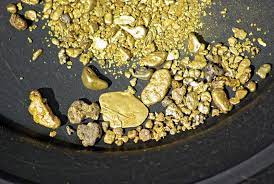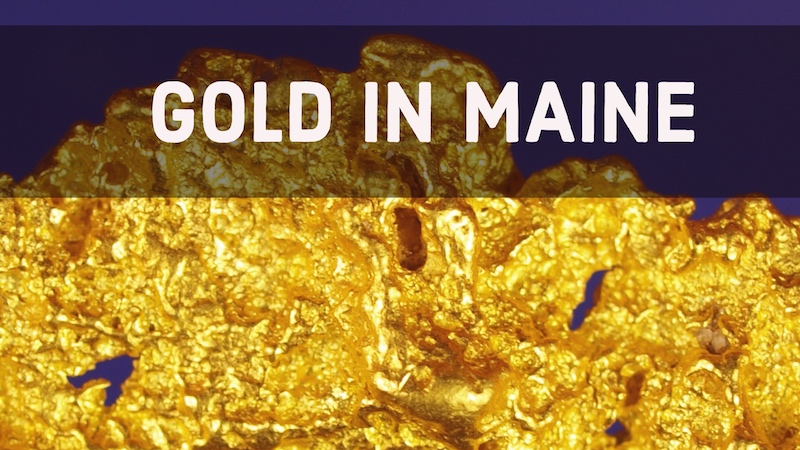
 |
|
FIGURE 1. Mining was in operation for nearly 60 years at Cache Creek, among the longest operated single placer deposit in Colorado. A BLM gate is open, allowing access to these present-day goldfields. Photo date 9/2007 by S. Veatch. |
Cache Creek Park produced over 49,000 ounces of gold—most of Chaffee County’s production (over $1 million at the old value of $20.67 per ounce). The area was worked by individual prospectors and small outfits from1859 until 1883 (figure 2). Starting in 1884, Cache Creek was worked as a large hydraulic mining operation—Colorado’s only profitable one—by several English firms. Mining operations continued until 1911 when mining was shut down in one of Colorado’s first environmental lawsuits. Since then there has been only intermittent small-scale placer mining (Parker, 1974). Most Colorado gold placers, produced by natural gravity concentration, were formed during the last Ice Age (the Pleistocene Epoch). Only a few placers were formed earlier, such as the late Eocene or early Oligocene Castle Rock Conglomerate (Parker, 1992). The earliest glacial period in Colorado is the pre-Bull Lake, followed by the Bull Lake. The last pulse of glaciation is known as the Pinedale. These names are from sites in Wyoming. Almost all of the Pleistocene placers in Colorado have been affected by either Bull Lake or Pinedale age glaciations, which altered or destroyed any earlier glacial deposits. Gold was concentrated by glacial melt water action and is often found near terminal moraines. Moraines are glacially formed accumulations of unconsolidated debris deposited where the glacier melted. These debris range from silt-like glacial flour to large boulders. Terminal or end moraines are ridges of unconsolidated debris deposited at the end of a glacier. Cache Creek Park was an outwash terrace of lower Bull Lake age; its gravels contained two sources of gold: 1) from the west or southwest, probably Lost Canyon Creek, and 2) the moraines of Lake Creek. In upper Bull Lake time these gravels were reworked by streams which brought in more gold from both of these two sources. The gold deposits of Cache Creek are found in placer gravels up to 61 feet high that are bordered on the north by the Bull Lake terminal moraine of the Lake Creek glacier and bordered on the west by Lost Canyon Mountain and on the east by a granite ridge (Parker, 1992). There is a bench about midway in the gravel: cobbles and boulders above it are less weathered than those beneath it, suggesting that the rocks below the bench were weathered for a much longer time. The gravel below the bench is lower Bull lake outwash; gravel above the bench is upper Bull Lake outwash. The bench is not present in all the parts of the gravel and reveals that the early Bull Lake outwash streams did not flow over the entire Park but were restricted to limited channels (Parker, 1992). Since the time major mining operations ended, the natural recovery of the Cache Creek area is slowly occurring. The Bureau of Land Management (BLM) manages the Cache Creek area for wildlife habitat, wetlands, and open space. Although the BLM has withdrawn the area from mineral entry, it has recognized Cache Creek’s important place in Colorado’s mining history and allows placer mining that minimizes impacts to the area. The BLM field office has established a 25 acre area for motorized placer mining. A permit from the local BLM office is required. The remaining BLM lands in the Cache Creek area are available for non-motorized placer mining, including pans, sluice boxes, and battery-operated re-circulators. The recreational placer season is limited to Memorial Day to November 30 of each year and limited to ten user days in order to minimize impacts to wildlife habitat. The Cache Creek area has been of interest to the small-scale prospectors because of the placer gold that was left behind when mining operations ended in 1911.

 |
|
FIGURE 2. Paul McRae, Shirley Weilnau, and Paul Yeisley take a break from their sluice box on Cache Creek. Photo date 7/2008 by S. Veatch. |
 |
|
FIGURE 3. A seasoned prospector is screening gold-bearing sediment from nearby glacial deposits. Photo date 7/2008 by S. Veatch. |
 |
| FIGURE 4 Larry Weilnau is carefully inspecting gold nuggets in his pan. Photo date 7/2008 by S. Veatch |
 |
|
FIGURE 5. Patrick Hill (left) and Luther Brown (right) are members of the Gold Prospectors of Colorado. Here they are running an effective panning operation on Cache Creek. The native gold has been concentrated by gravity concentration. Photo date 9/2007 by S. Veatch. |
(Information on BLM rules at Cache Creek and a copy of the permit
References Cited:
Armour, J., Fawcett, P.J. and Geissman, J.W. 2002. 15 k.y. paleoclimatic and glacial record from northern New Mexico. Geology 30(8):723-726. Chronology of Colorado History. Retrieved October 11, 2007, from Colorado State Archives Web site: http://www.colorado.gov/dpa/doit/archives/ Davis, M.W., and R. K. Streufert, 1990, Gold Occurrences of Colorado., Resource Series 28: Colorado Geological Survey, Denver, Colorado, 101 p Parker, B.H., Jr. 1974, Gold placers of Colorado (2 volumes). Colorado School of Mines Quarterly, v. 69, no. 3, 492 p. Parker, B.H., Jr. 1992. Gold panning and placering in Colorado: How and where, Information Series 33: Colorado Geological Survey, Denver, Colorado, 83 p. Richmond, G.M. 1965. Glaciation of the Rocky Mountains. in, Wright, H.E. Jr. and Frey, D.G. (eds.), The Quaternary of the United States, p. 217-230. Princeton University Press, Princeton, New Jersey.
 Richmond, G.M. 1986. Stratigraphy and correlation of glacial deposits of the Rocky Mountains, the Colorado Plateau, and the ranges of the Great Basin. in, Sibrava, V., Bowen, D.Q. and Richmond, G.M. (eds.), Quaternary glaciations in the northern hemisphere, p. 99-127. Pergamon Press, Oxford & New York.
Richmond, G.M. 1986. Stratigraphy and correlation of glacial deposits of the Rocky Mountains, the Colorado Plateau, and the ranges of the Great Basin. in, Sibrava, V., Bowen, D.Q. and Richmond, G.M. (eds.), Quaternary glaciations in the northern hemisphere, p. 99-127. Pergamon Press, Oxford & New York.

